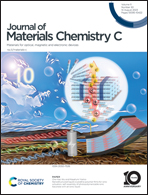Suppression of nonradiative transitions of triplet excitons via a fused/non-fused strategy for realizing efficient room-temperature phosphorescence†
Abstract
Two purely organic room temperature phosphorescence (RTP) molecules containing sulfur atoms and carbonyl groups, namely FBPSP with a fused-ring structure and BPSP with a non-fused ring structure, are designed and synthesized to investigate the effect of the fused or non-fused molecular backbones on the RTP performance. Compared to the non-fused BPSP, the fused FBPSP exhibits excellent structural rigidity and planarity, rendering a smaller structural change, lower reorganization energy and decreased Huang–Rhys factor for its T1 to S0 transition, as revealed by theoretical calculations. As a result, FBPSP shows fluorescence and RTP dual emission in dilute solution, while only weak fluorescence can be observed for BPSP solution. Especially, FBPSP shows bright green phosphorescence in doped films with a phosphorescence quantum yield (ΦP) of up to 47.0%, which is significantly higher than that of BPSP (0.3%). On the other hand, the non-fused BPSP with a rotatable and twisted skeleton displays yellow RTP emission with an enhanced ΦP of 6.9% in its crystal state due to the inhibited π–π stacking, around two times higher than that of the FBPSP crystal (ΦP of 2.3%) with strong π–π interactions, which is further explained by single crystal analysis and theoretical calculation studies. This work provides insights into the design and construction of RTP materials with tunable RTP properties in different states of matter.



 Please wait while we load your content...
Please wait while we load your content...